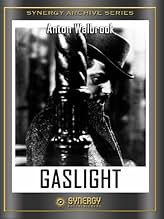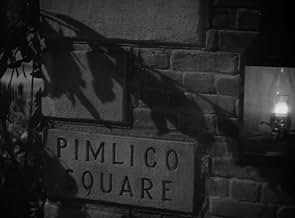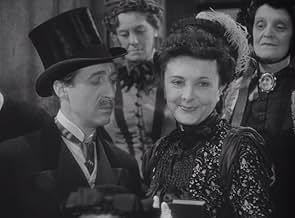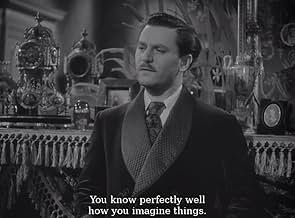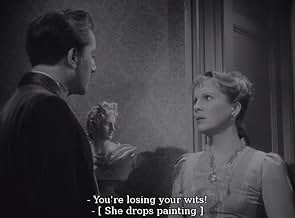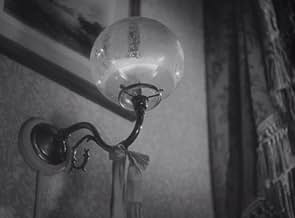IMDb RATING
7.3/10
5.7K
YOUR RATING
Twenty years after the murder of Alice Barlow, her house is finally occupied again. However, the husband from the couple who has moved in has a secret that he will do anything to keep hidden... Read allTwenty years after the murder of Alice Barlow, her house is finally occupied again. However, the husband from the couple who has moved in has a secret that he will do anything to keep hidden.Twenty years after the murder of Alice Barlow, her house is finally occupied again. However, the husband from the couple who has moved in has a secret that he will do anything to keep hidden.
- Director
- Writers
- Stars
Alfred Atkins
- Bit Role
- (uncredited)
Edwin Ellis
- Bit Role
- (uncredited)
Kathleen Harrison
- Bit Role
- (uncredited)
Katie Johnson
- Alice Barlow's Maid
- (uncredited)
Molly Raynor
- Bit Role
- (uncredited)
- Director
- Writers
- All cast & crew
- Production, box office & more at IMDbPro
Featured reviews
The later version is Hollywood English, which I sometimes think is a downtown section of Hollywood Transylvanian. Believe me, the original is the real thing, from the small details up to the social assumptions: it's recognisably English. As such, the thriller is grounded in a reality that the later version can never have. And so it's scary! Of course, I admit that this justification of the original might be a lot less convincing if you're reading my words on the other side of the world...
As for the difficulty of getting hold of a copy, well every few years it's shown on one TV station or another over here, so there has to be a good copy somewhere out there.
As for the difficulty of getting hold of a copy, well every few years it's shown on one TV station or another over here, so there has to be a good copy somewhere out there.
10preppy-3
It's easy to see why MGM locked this away in their vaults when they issued their 1944 remake--it's really great!
An evil crook (Anton Walbrook) slowly tries to drive his wife (Diana Wynyard) mad for some jewels.
This isn't as lush as the remake, but it more than makes up for it in other departments. For one thing--it's shorter by about 30 minutes and there's no romantic interlude at the beginning. This one starts dark and gets darker. Walbrook is frightening as the husband--much better than Charles Boyer in the remake. The scenes where he yells at his wife had me jumping. Wynyard is great as his fragile wife. She doesn't go into hysterics and chew the scenery like Ingrid Bergman did--she plays it calmly and quietly and very very realistically. Her final confrontation with her husband was just great. Also Cathleen Cordell is lots of fun as Nancy, the parlor maid. In the remake she was played by Angela Landsbury (in her film debut). Surprisingly, Cordell is better than Landsbury!
The remake copied this film virtually scene by scene--and suffers somewhat by comparison. It added on the unnecessary romantic subplot with Joseph Cotton. Thankfully, there's nothing like that here. This just grips you from the very beginning and doesn't let go.
Both movies are great but this one is marginally better. Very recommended.
An evil crook (Anton Walbrook) slowly tries to drive his wife (Diana Wynyard) mad for some jewels.
This isn't as lush as the remake, but it more than makes up for it in other departments. For one thing--it's shorter by about 30 minutes and there's no romantic interlude at the beginning. This one starts dark and gets darker. Walbrook is frightening as the husband--much better than Charles Boyer in the remake. The scenes where he yells at his wife had me jumping. Wynyard is great as his fragile wife. She doesn't go into hysterics and chew the scenery like Ingrid Bergman did--she plays it calmly and quietly and very very realistically. Her final confrontation with her husband was just great. Also Cathleen Cordell is lots of fun as Nancy, the parlor maid. In the remake she was played by Angela Landsbury (in her film debut). Surprisingly, Cordell is better than Landsbury!
The remake copied this film virtually scene by scene--and suffers somewhat by comparison. It added on the unnecessary romantic subplot with Joseph Cotton. Thankfully, there's nothing like that here. This just grips you from the very beginning and doesn't let go.
Both movies are great but this one is marginally better. Very recommended.
What a crisp, deeply rooted thriller Thorold Dickinson created. With vile creatures (Paul) and goofy policemen and maids, we are easily captured into the world of the Mallens. Diana Wynyard does a spectacular job as Bella, giving us the right amount of insecurity coupled with fear. She is the true victim of this film and Dickinson does not let us forget that. Wynyard is nearly overshadowed by my favorite character of the film, Paul Mallen, played with so much evil by Anton Walbrook. I have seen several films in my life, and I must say that Walbrook ranks among some of the most sinister villains of them all. He has no super powers, just the ability to manipulate Bella mentally, proving that he is stronger than her. He thrives on Bella's insecurities and makes them into his greatest form of punishment. These two working together really transformed this 40s thriller into something concrete and powerful. It is the dynamic between the two that kept me glued to my seat and continually asking for more.
Coupled with the superb acting is the creativeness of Dickinson and his writer A.R. Rowlinson. Together they set the mood with darkened corners and alleyways with that constantly looming feeling that the events are going to get grittier down the road. This team made Victorian London a spooky place to visit at night. They make Bella the victim throughout this entire film, making even me wonder if she really was slowly going mad. It isn't until the end that the truth is revealed and even then we are left in suspense. It isn't until the credits roll is the film over, and that is hard to accomplish for directors of the thriller genre today. Dickinson proved that he could handle all the elements with the greatest of ease and bring them to the screen in a film that would last the test of time. I am not embarrassed to show this film to friends because I do believe that they would see the value in this production.
Grade: ***** out of *****
Coupled with the superb acting is the creativeness of Dickinson and his writer A.R. Rowlinson. Together they set the mood with darkened corners and alleyways with that constantly looming feeling that the events are going to get grittier down the road. This team made Victorian London a spooky place to visit at night. They make Bella the victim throughout this entire film, making even me wonder if she really was slowly going mad. It isn't until the end that the truth is revealed and even then we are left in suspense. It isn't until the credits roll is the film over, and that is hard to accomplish for directors of the thriller genre today. Dickinson proved that he could handle all the elements with the greatest of ease and bring them to the screen in a film that would last the test of time. I am not embarrassed to show this film to friends because I do believe that they would see the value in this production.
Grade: ***** out of *****
Gaslight (1940) In 1944, MGM released a movie about a thief who slowly tries to drive his wife insane in order to find out the location of some jewels. The movie was called Gaslight, and it starred Charles Boyer and Ingrid Bergman. But the movie wasn't an MGM original by any means; its antecedent was a much-lesser-known 1940 British film by the same name. (Apparently, when MGM bought the rights to the story, based on a play by Patrick Hamilton, the studio attempted to destroy all existing prints of the earlier version, but they weren't successful.) In the opening scene, an old woman is strangled to death, and her killer ransacks her apartment in search of... well, something. His search is apparently fruitless. Years later, Paul Mallen (Anton Walbrook), a debonair society lord in London, moves with his wife Bella (Diana Wynyard) to the posh Pimlico Square, directly below the apartment of the murdered. Mrs. Mallen is quickly the talk of the neighborhood - she's a little off, they say. Something's not quite right with her. And those wags are right; Bella is constantly accused by her husband of stealing things from him, although she has no recollection of the events.
Mallen uses trick after psychological trick against his wife, although it's unclear to the audience what his motives are. Is he just playing with her? Does he merely delight in her anguish? He even deliberately keeps her from her cousin, a man who'd stood against their marriage at the wedding ceremony. What's Mallen's angle? Unlike its remake, this earlier version is delightfully understated - and bereft of stars whose names would be recognizable in the United States. It's remarkably well lit, too, typical for movies of the period. But where it draws most of its strength is from the two leads. Walbrook, who by that time had been in motion pictures for 25 years, is perfect as the sly, debonair, and viciously evil Mallen; Wynyard exudes vulnerability and panic; her Bella is terrified that she might be quite sincerely insane, vacillating from dignified serenity to sheer panic.
This movie is highly recommended to fans of noir film, particularly those who've seen the more-famous 1944 Hollywood version.
Mallen uses trick after psychological trick against his wife, although it's unclear to the audience what his motives are. Is he just playing with her? Does he merely delight in her anguish? He even deliberately keeps her from her cousin, a man who'd stood against their marriage at the wedding ceremony. What's Mallen's angle? Unlike its remake, this earlier version is delightfully understated - and bereft of stars whose names would be recognizable in the United States. It's remarkably well lit, too, typical for movies of the period. But where it draws most of its strength is from the two leads. Walbrook, who by that time had been in motion pictures for 25 years, is perfect as the sly, debonair, and viciously evil Mallen; Wynyard exudes vulnerability and panic; her Bella is terrified that she might be quite sincerely insane, vacillating from dignified serenity to sheer panic.
This movie is highly recommended to fans of noir film, particularly those who've seen the more-famous 1944 Hollywood version.
Although Ingrid Bergman and Charles Boyer got a lot of press for the movie GASLIGHT, the film was actually a remake of a British film made only a few years earlier. It seems that the big-wigs at the studio wanted to remake the film but pretend that it was an original Hollywood production so they bought up the prints and the remade film went on to be considered a "classic". However, recently the ORIGINAL version from 1940 has been discovered and has been shown on Turner Classic Movies.
Having seen both versions, I found them awfully similar--but I would have to say that I preferred the original. The wonderful Anton Walbrook was a wonderful and even more menacing husband and I just could see no reason why the movie should have been remade. It's really a shame, too, as I am sure that those associated with the original must have wished they'd gotten all the attention the 1944 version received.
My advice is see them both. However, if you only plan on seeing one, see this one--it's just a better film!
Having seen both versions, I found them awfully similar--but I would have to say that I preferred the original. The wonderful Anton Walbrook was a wonderful and even more menacing husband and I just could see no reason why the movie should have been remade. It's really a shame, too, as I am sure that those associated with the original must have wished they'd gotten all the attention the 1944 version received.
My advice is see them both. However, if you only plan on seeing one, see this one--it's just a better film!
Did you know
- TriviaWhen MGM remade the film with Charles Boyer and Ingrid Bergman, the studio attempted to have all prints of this earlier version destroyed. Fortunately, several prints escaped the fire (in fact, it is believed that director Thorold Dickinson surreptitiously struck a print himself before the negative was lost).
- GoofsAfter the murder of the old lady in 1865, a police constable is shown blowing a whistle to summon assistance. Whistles were not used by the Metropolitan Police until the 1870s; prior to that they used a football rattle to attract attention.
- ConnectionsFeatured in The Kenny Report: Episode dated 3 September 2024 (2024)
- SoundtracksThe Can-Can
(uncredited)
from "Orpheus in the Underworld"
Music by Jacques Offenbach
Arranged by Richard Addinsell
Played at the music hall and danced to by The Darmora Ballet
- How long is Angel Street?Powered by Alexa
Details
- Runtime
- 1h 24m(84 min)
- Color
- Aspect ratio
- 1.37 : 1
Contribute to this page
Suggest an edit or add missing content

